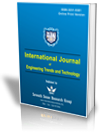Recent Advances in the Synthesis of Indolizines and their Derivatives
Recent Advances in the Synthesis of Indolizines and their Derivatives |
||
 |
 |
|
| © 2025 by IJETT Journal | ||
| Volume-73 Issue-4 |
||
| Year of Publication : 2025 | ||
| Author : Ho Soonmin, Basavaraj Padmashali |
||
| DOI : 10.14445/22315381/IJETT-V73I4P113 | ||
How to Cite?
Ho Soonmin, Basavaraj Padmashali, "Recent Advances in the Synthesis of Indolizines and their Derivatives," International Journal of Engineering Trends and Technology, vol. 73, no. 4, pp.130-138, 2025. Crossref, https://doi.org/10.14445/22315381/IJETT-V73I4P113
Abstract
The synthesis of indolizine via conventional methods, reaction necessitates several hours and some under reflux conditions, and the usage of expensive catalysts like palladium, copper, rhodium, titanium and silver. These reactions are typically time-consuming, mandating prolonged reflux conditions and the usage of hazardous solvents to nature. Although, with these significant resources, the yield obtained is satisfactory. Furthermore, it also makes the synthesis cost-effective, but it also punishes the environment due to the hazardous waste generated. In this study, we report that synthesising indolizine by adapting a green technique over the conventional method would diminish environmental impact while boosting efficiency and perpetuity in indolizine synthesis.
Keywords
Bioactive, 1,3-Dipolar cycloaddition eco-friendly microwave, Indolizine, Diseases, Illness.
References
[1] Yushuang Liu et al., “A Novel Indolizine Derivative Induces Apoptosis through the Mitochondria p53 Pathway in HepG2 Cells,” Frontiers in Pharmacology, vol. 10, pp. 1-12, 2019.
[CrossRef] [Google Scholar] [Publisher Link]
[2] DaWon Kim et al., “Fluorescent Indolizine Derivative YI-13 Detects Amyloid-β Monomers, Dimers, and Plaques in the Brain of 5XFAD, Alzheimer Transgenic Mouse Model,” Plos One, vol. 15, no. 12, pp. 1-20, 2020.
[CrossRef] [Google Scholar] [Publisher Link]
[3] Kui Zeng et al., “A Recyclable Stereoauxiliary Aminocatalyzed Strategy for One-Pot Synthesis of Indolizine-2-Carbaldehydes,” Communications Chemistry, vol. 6, no. 1, pp. 1-9, 2023.
[CrossRef] [Google Scholar] [Publisher Link]
[4] William B. Harrell, and Robert F. Doerge, “Mannich Bases from 2‐Phenylindolizines I. 3‐Alkyl‐1‐Dialkylaminomethyl Derivatives,” Journal of Pharmaceutical Sciences, vol. 56, no. 2, pp. 225-228, 1967.
[CrossRef] [Google Scholar] [Publisher Link]
[5] D. Leaver, Chapter 37 - Fused Heterocyclic Systems Having a Nitrogen Atom Common to Two or More Rings, Supplements to the 2nd Edition of Rodd's Chemistry of Carbon Compounds, vol. 4, pp. 33-54, 1975.
[CrossRef] [Google Scholar] [Publisher Link]
[6] Stephen G. Pyne, “Recent Developments on the Synthesis of (-)-Swainsonine and Analogues,” Current Organic Synthesis, vol. 2, no. 1, pp. 39-57, 2005.
[CrossRef] [Google Scholar] [Publisher Link]
[7] Sarita Mishra, Bikramaditya Naskar, and Rina Ghosh, “CuCl Catalyzed Green and Efficient One-Pot Synthesis of Aminoindolizine Frameworks via Three-Component Reactions of Aldehydes, Secondary Amines, and Terminal Alkynes in PEG,” Tetrahedron Letters, vol. 53, no. 41, pp. 5483-5487, 2012.
[CrossRef] [Google Scholar] [Publisher Link]
[8] Toshio Honda et al., “Enantiospecific Synthesis of an Indolizidine Alkaloid, (+)-Ipalbidine,” Tetrahedron Letters, vol. 44, no. 15, pp. 3035-3038, 2003.
[CrossRef] [Google Scholar] [Publisher Link]
[9] Linyi Wei et al., “Antitumor Agents 248, Chemistry and Antitumor Activity of Tylophorinerelated Alkaloids,” Studies in Natural Products Chemistry, vol. 34, pp. 3-34, 2008.
[CrossRef] [Google Scholar] [Publisher Link]
[10] Angeline Cyriac, Toji Thomas, and T. Dennis Thomas, Tylophorine: Sources, Properties, Applications and Biotechnological Production, Plant-Derived Bioactives, Springer, Singapore, pp. 167-176, 2020.
[CrossRef] [Google Scholar] [Publisher Link]
[11] Giulia Venditti et al., “1, 5-Diarylpyrroles as Potent Antitubercular and Anti-Inflammatory Agents,” Chemistry of Heterocyclic Compounds, vol. 53, pp. 281-291, 2017.
[CrossRef] [Google Scholar] [Publisher Link]
[12] Santanu Bhadra et al., Chapter 13 - Evaluation of Bioactive Compounds as Acetylcholinesterase Inhibitors from Medicinal Plants, Evidence-Based Validation of Herbal Medicine, Elsevier, pp. 273-306, 2015.
[CrossRef] [Google Scholar] [Publisher Link]
[13] Andreea Veronica Dediu Botezatu et al., “Green “One-Pot” Fluorescent Bis-Indolizine Synthesis with Whole-Cell Plant Biocatalysis,” Green Processing and Synthesis, vol. 12, no. 1, pp. 1-22, 2023.
[CrossRef] [Google Scholar] [Publisher Link]
[14] Girija S. Singh, and Edward E. Mmatli, “Recent Progress in Synthesis and Bioactivity Studies of Indolizines,” European Journal of Medicinal Chemistry, vol. 46, no. 11, pp. 5237-5257, 2011.
[CrossRef] [Google Scholar] [Publisher Link]
[15] Peter Spargo, “Green Chemistry: An Introductory Text by Mike Lancaster. Royal Society of Chemistry: Cambridge, UK. 2002. 310 pp. £25. ISBN 0-85404-620-8,” Organic Process Research & Development, vol. 8, no. 2, pp. 299-300, 2004.
[CrossRef] [Google Scholar] [Publisher Link]
[16] Richard Gedye, “Microwave-Enhanced Chemistry: Fundamentals, Sample Preparation, and Applications,” Journal of the American Chemical Society, vol. 121, no. 19, pp. 4729-4729, 1999.
[CrossRef] [Google Scholar] [Publisher Link]
[17] Peter Spargo, “Microwaves in Organic Synthesis,” Organic Process Research & Development, vol. 8, no. 2, pp. 298-298, 2004.
[CrossRef] [Google Scholar] [Publisher Link]
[18] Hafid Benakki et al., “Microwave-Assisted Multi-Step Synthesis of Novel Pyrrolo-[3, 2-c] Quinoline Derivatives,” Tetrahedron, vol. 64, no. 25, pp. 5949-5955, 2008.
[CrossRef] [Google Scholar] [Publisher Link]
[19] Richard Gedye et al., “The Use of Microwave Ovens for Rapid Organic Synthesis,” Tetrahedron Letters, vol. 27, no. 3, pp. 279-282, 1986.
[CrossRef] [Google Scholar] [Publisher Link]
[20] Raymond J. Giguere et al., “Application of Commercial Microwave Ovens to Organic Synthesis,” Tetrahedron Letters, vol. 27, no. 41, pp. 4945-4948, 1986.
[CrossRef] [Google Scholar] [Publisher Link]
[21] Camelia Gabriel et al., “Dielectric Parameters Relevant to Microwave Dielectric Heating,” Chemical Society Reviews, vol. 27, no. 3, pp. 213-224, 1998.
[CrossRef] [Google Scholar] [Publisher Link]
[22] Emilian Georgescu et al., “Microwave-Assisted Multicomponent Synthesis of Benzo [f] pyrrolo [1, 2-a] Quinoline Derivatives,” Romanian Review of Chemistry, vol. 65, no. 1, pp. 97-102, 2020.
[Google Scholar] [Publisher Link]
[23] E.T. Borrows, and D.O. Holland, “The Chemistry of the Pyrrocolines and the Octahydropyrrocolines,” Chemical Reviews, vol. 42, no. 3, pp. 611 643, 1948.
[CrossRef] [Google Scholar] [Publisher Link]
[24] Kalpana Garg, Komal Goswami, and Gaurav Khurana, “A Pharmacognostical Review on Elaeocarpus Sphaericus,” International Journal of Pharmacy and Pharmaceutical Sciences, vol. 5, no. 1, pp. 3-8, 2013.
[Google Scholar]
[25] Joseph P. Michael, “Indolizidine and Quinolizidine Alkaloids,” Natural Product Reports, vol. 25, no. 1, pp. 139-165, 2008.
[CrossRef] [Google Scholar] [Publisher Link]
[26] Bing-Xiang Wang et al., “Oxidant Promoted 1, 3‐Dipolar Cycloaddition of Pyridinium Ylides to Chalcones for Preparation of 1‐Benzoyl‐2‐Arylindolizines,” Chinese Journal of Chemistry, vol. 24, no. 2, pp. 279-281, 2006.
[CrossRef] [Google Scholar] [Publisher Link]
[27] Evangelina Boultadakis et al., “Synthesis of Substituted Indolizines and Pyrrolo [2, 1-a] Isoquinolines from 1, 1-Diiodo-2, 2-Dinitroethylene,” Synlett, vol. 2002, no. 9, pp. 1547-1549, 2002.
[CrossRef] [Google Scholar] [Publisher Link]
[28] Guizhou Yue et al., “Synthesis of a Library of Benzoindolizines Using Poly (Ethylene Glycol) as Soluble Support,” Bioorganic & Medicinal Chemistry Letters, vol. 15, no. 2, pp. 453-458, 2005.
[CrossRef] [Google Scholar] [Publisher Link]
[29] Yun Liu et al., “Regioselective Synthesis of 3-Acylindolizines and Benzo-Analogues via 1, 3-Dipolar Cycloadditions of N-Ylides with Maleic Anhydride,” Organic & Biomolecular Chemistry, vol. 8, no. 10, pp. 2449-2456, 2010.
[CrossRef] [Google Scholar] [Publisher Link]
[30] Kiyoshi Matsumoto et al., “1, 3-Dipolar Cycloaddition of 1-Phenylpropa-1,2-Diene with Pyridinium Dicyanomethylides: 1-Phenylpropa-1,2-Diene as a Synthetic Equivalent of 1-Phenylpropyne,” Heterocycles, vol. 54, no. 2, pp. 611-614, 2001.
[CrossRef] [Google Scholar] [Publisher Link]
[31] Tyler J. Harrison et al., “Pyrrole Synthesis Catalyzed by AgOTf or Cationic Au (I) Complexes,” The Journal of Organic Chemistry, vol. 71, no. 12, pp. 4525-4529, 2006.
[CrossRef] [Google Scholar] [Publisher Link]
[32] Inma R. Lahoz et al., “Mechanistic Investigation on the Formation of Indolizines from 2-Enynylpyridines,” Organic Letters, vol. 11, no. 21, pp. 4802-4805, 2009.
[CrossRef] [Google Scholar] [Publisher Link]
[33] Stefan E. Boiadjiev, and David A. Lightner, “Readily Synthesized Novel Fluorescent Dipyrrinones,” The Journal of Organic Chemistry, vol. 70, no. 2, pp. 688-691, 2005.
[CrossRef] [Google Scholar] [Publisher Link]
[34] Teresa Przewloka et al., “Application of DMF-Methyl Sulfate Adduct in the Regioselective Synthesis of 3-Acylated Indolizines,” Tetrahedron Letters, vol. 48, no. 33, pp. 5739-5742, 2007.
[CrossRef] [Google Scholar] [Publisher Link]
[35] Sujit Ghosh, and Kinkar Biswas, “Microwave-Assisted Synthesis of Indolizine Derivatives: Recent Developments: A Review (2003-present),” Synthetic Communications, vol. 54, no. 7, pp. 505-525, 2024.
[CrossRef] [Google Scholar] [Publisher Link]
[36] Yoshiyuki Hari, Takayuki Shioiri, and Toyohiko Aoyama, “Synthesis of Heterocycles Using Trimethylsilyldiazomethane,” Journal of Synthetic Organic Chemistry, vol. 67, no. 4, pp. 357-368, 2009.
[CrossRef] [Google Scholar] [Publisher Link]
[37] Ikyon Kim et al., “Expeditious Synthesis of Indolizine Derivatives via Iodine Mediated 5-Endo-Dig Cyclization,” Tetrahedron Letters, vol. 48, no. 39, pp. 6863-6867, 2007.
[CrossRef] [Google Scholar] [Publisher Link]
[38] Ikyon Kim et al., “A Novel and Efficient Approach to Highly Substituted Indolizines via 5-Endo-Trig Iodocyclization,” Tetrahedron, vol. 63, no. 52, pp. 12954-12960, 2007.
[CrossRef] [Google Scholar] [Publisher Link]
[39] Simon Rečnik et al., “Ring Contractions of 3-Azido-4H-Quinolizin-4-Ones and 3-Azido-4H-Azino [1, 2–x] Pyrimidin-4-Ones: A Novel Approach to 3-Aminoindolizines and their Aza Analogues,” Australian Journal of Chemistry, vol. 61, no. 2, pp. 107-114, 2008.
[CrossRef] [Google Scholar] [Publisher Link]
[40] David A. James et al., “Indole- and Indolizine-Glyoxylamides Displaying Cytotoxicity Against Multidrug Resistant Cancer Cell Lines,” Bioorganic & Medicinal Chemistry Letters, vol. 18, no. 6, pp. 1784-1787, 2008.
[CrossRef] [Google Scholar] [Publisher Link]
[41] Vijayakumar Uppar et al., “Microwave Induced Synthesis, and Pharmacological Properties of Novel 1-Benzoyl-4-Bromopyrrolo [1, 2-a] Quinoline-3-Carboxylate Analogues,” Chemical Data Collections, vol. 25, 2020.
[CrossRef] [Google Scholar] [Publisher Link]
[42] Solomon Teklu et al., “Indolizine 1-Sulfonates as Potent Inhibitors of 15-Lipoxygenase from Soybeans,” Bioorganic & Medicinal Chemistry, vol. 13, no. 9, pp. 3127-3139, 2005.
[CrossRef] [Google Scholar] [Publisher Link]
[43] Olayinka O. Ajani et al., “Microwave Assisted Synthesis and Antimicrobial Potential of Quinoline‐Based 4‐Hydrazide‐Hydrazone Derivatives,” Journal of Heterocyclic Chemistry, vol. 55, no. 1, pp. 302-312, 2018.
[CrossRef] [Google Scholar] [Publisher Link]
[44] Rajesh Raju et al., “Environmentally Friendly Synthesis and Computational Studies of Novel Class of Acridinedione Integrated Spirothiopyrrolizidines/Indolizidines,” Green Processing and Synthesis, vol. 12, no. 1, pp. 1-18, 2023.
[CrossRef] [Google Scholar] [Publisher Link]
[45] Rob C. Oslund, Nathan Cermak, and Nathan Cermak, “Highly Specific and Broadly Potent Inhibitors of Mammalian Secreted Phospholipases A2,” Journal of Medicinal Chemistry, vol. 51, no. 15, pp. 4708-4714, 2008.
[CrossRef] [Google Scholar] [Publisher Link]
[46] L. Nathan Tumey, Chapter 4: CRTH2 Antagonists, Anti-Inflammatory Drug Discovery, Royal Society of Chemistry, pp. 104-134, 2012.
[Google Scholar] [Publisher Link]
[47] Oren Zimhony et al., “Pyrazinoic Acid and Its n-Propyl Ester Inhibit Fatty Acid Synthase Type I in Replicating Tubercle Bacilli,” Antimicrobial Agents and Chemotherapy, vol. 51, no. 2, pp. 752-754, 2007.
[CrossRef] [Google Scholar] [Publisher Link]
[48] Marjan Esfahanizadeh et al., “Synthesis and Evaluation of New Fluorinated Anti-Tubercular Compounds,” Iranian Journal of Pharmaceutical Research, vol. 13, no. 1, pp. 115-126, 2014.
[Google Scholar] [Publisher Link]
[49] Guitele Dalia Goldhaber-Pasillas, Young Hae Choi, and Robert Verpoorte, “Chapter Nine - New Methods of Analysis and Investigation of Terpenoid Indole Alkaloids,” Advances in Botanical Research, vol. 68, pp. 233-272, 2013.
[CrossRef] [Google Scholar] [Publisher Link]
[50] Xing-yue Ji et al., “Design, Synthesis Antiproliferative Activity of a Novel Class of Indole-2-Carboxylate Derivatives,” European Journal of Medicinal Chemistry, vol. 83, pp. 409-418, 2014.
[CrossRef] [Google Scholar] [Publisher Link]
[51] Ari M.P Koskinen, and Oili A. Kallatsa, “Polyhydroxylated Indolizidine Alkaloids-An Efficient Synthesis of 1-Deoxy-8,8a-Di-Epi-Castanospermine,” Tetrahedron, vol. 59, no. 35, pp. 6947-6954, 2003.
[CrossRef] [Google Scholar] [Publisher Link]
[52] Syahrul Imran et al., “Synthesis of Novel Bisindolylmethane Schiff Bases and Their Antibacterial Activity,” Molecules, vol. 19, no. 8, pp. 11722-11740, 2014.
[CrossRef] [Google Scholar] [Publisher Link]

